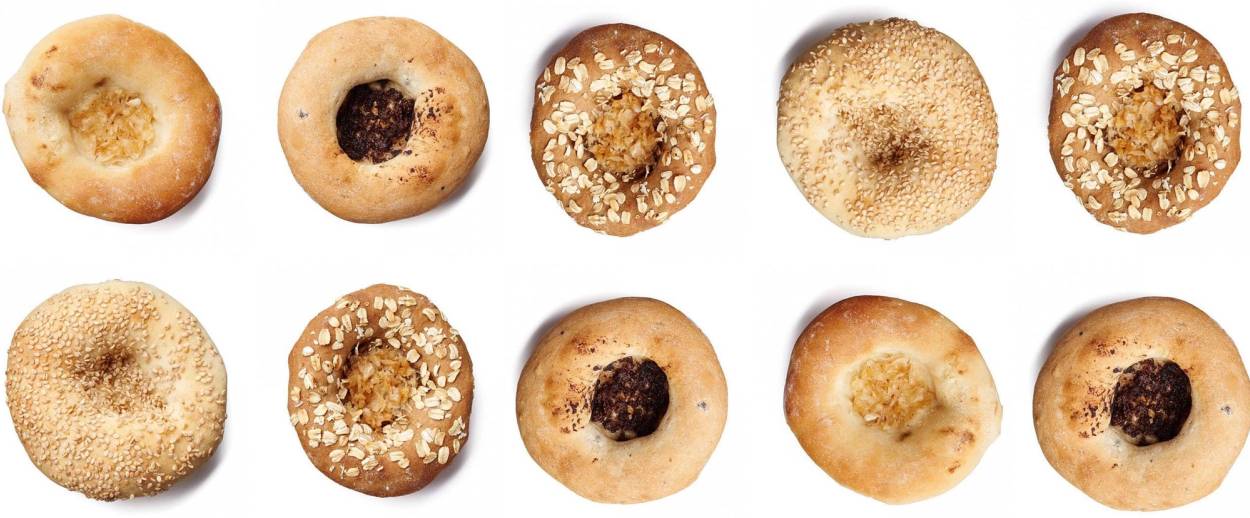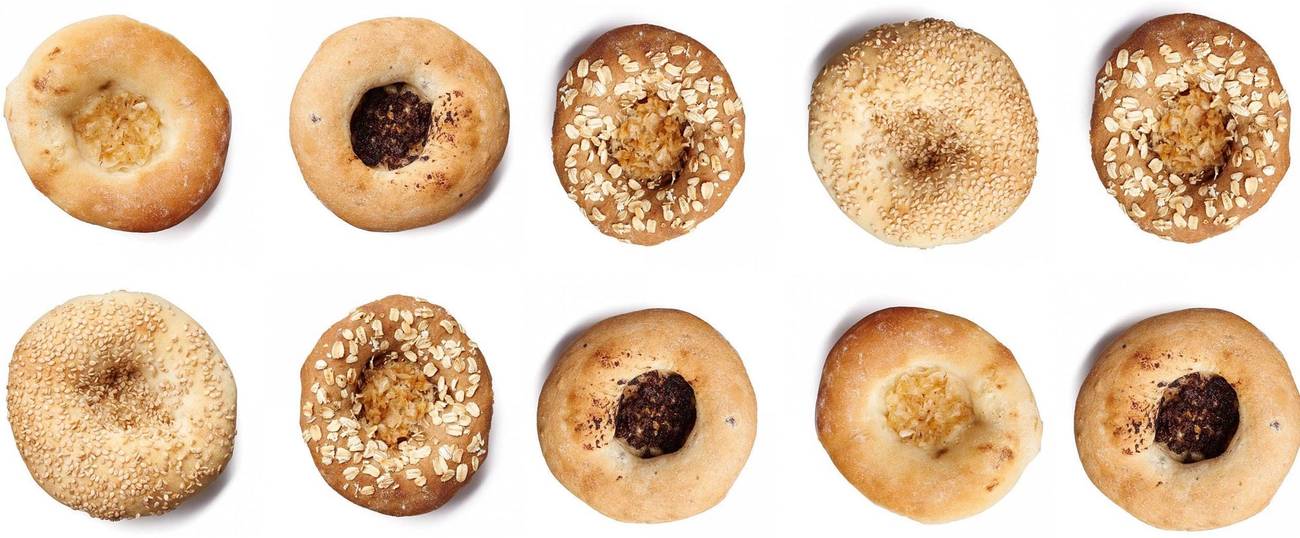Kossar’s, the 80-Year-Old Bialy Store, Has Still Got It
Face-lift complete, the shop’s specialty is as good as ever




Last Sunday, I attended a panel about Jewish Lower East Side history at the Museum at Eldridge Street. I already knew that participants Zalmen Mlotek, Artistic Director of the National Yiddish Theatre Folksbiene, and Laurie Gwen Shapiro, Emmy-nominated filmmaker/documentarian/oral historian/novelist/gal-about-Jewy-town, were fun speakers. But I really wanted to hear from Evan Giniger, new co-owner of Kossar’s Bialys, the 80-year-old bakery on Grand Street that reopened this month after a five-month renovation. Neighborhood Cassandras, always wary of change, were furious at this parvenu who’d promised to modernize an ancient treasure. I figured an entire shul full of elderly Jews would be eager to yell at him, which would be entertaining.
But first I had to get inside. I’d reserved a seat for the sold-out event, but a line of undifferentiated ticket-holders and wait-list wannabes led all the way down the block, becoming increasingly agitated. I wound up pulling the dick move of going to the front of the line and announcing that I was press. A retired Washington Post journalist waiting patiently to be admitted kindly encouraged me to throw elbows, in accordance with our people’s traditions. (Journalists, not Jews.) (Also, I think it may have been this guy, and if so, sir, I am so sorry I didn’t recognize you and can I interview you sometime?)
Once I actually made it into the building I kvelled at the beautifully restored shul/museum. This once-crumbling, dusty edifice, which I’d visited as a child on a trip from Rhode Island, has been restored to former glory. It’s now full of life, with kids and families visiting on Sundays, programming throughout the week, older folks having services on Shabbat. The sanctuary, built in 1887, is full of over-the-top trompe l’oeil murals, painted faux-marble columns, ornate Victorian carved wood detailing. Amy Stein Milford, the museum’s deputy director, said that architects call the style horror vacui, Latin for “fear of empty space.” (In Yiddish, we call it ungapatchka.) It is too much of a muchness, and it is fabulous. Above it all is the turquoise and gold stained glass window designed by Kiki Smith—simultaneously Jewish, Moorish, American-folk-arty, and modernist.
When it was Giniger’s turn to present, he asked if everyone knew what a bialy was. There was snorting from the crowd. But hey, maybe someone quiet didn’t know? The unprepossessing 50-something gentleman held up a little disc of carbs. “This is a bialy!” he announced. Everyone applauded. “It’s thinner and lighter than a bagel,” he continued. “Some people call it the Jewish English muffin. It’s baked—unlike a bagel, which is boiled and then baked—and it has just four ingredients: Flour, kosher salt, water and yeast. Traditionally it’s filled in the center with roasted onions or garlic, but we now have flavors like sundried tomato and pesto and olive.” I felt the room’s distrust at this news.
The word bialy is short for “Bialystoker kuchen” which is Polish for “bread from Bialystok.” The bialy was so central to immigrant Lower East Side Jewish life that bialy bakers had their own union, separate from the Bagel Bakers Association. (“They didn’t get along,” noted Giniger.) Kossar’s was co-founded by Morris Kossar and Isadore Mirsky in 1936; in the ‘50s, Kossar bought out his partner and the store moved from Ridge Street to Clinton Street; in 1960 it moved to its current location on Grand and Essex. At the bialy business’s peak, Giniger said, “they made 5000 dozen bialys a week. I’ll do that math for you—it’s a million bialys a year.” Bakers worked 24 hours a day, sometimes sleeping on bags of flour in the basement.
In 1958, Kossar’s on Clinton blew up. Police found a wire leading from the store’s basement to a battery two storefronts down, at 141 Clinton. Foul play was suspected. (Morris Kossar had recently resigned from the neighborhood Bialy Bakers Association union and signed with the local chapter of the national Bakery and Confectionary Workers Union.) The bakery was empty and no one was hurt, but Morris’s mother, who lived above the store, was taken to Gouverneur Hospital as a precaution. “The police said Mrs. Kossar had a heart ailment that might have been aggravated,” wrote the Times, in perhaps the most Jewish sentence ever to appear in that paper, which is saying something.
Sadly, this was far from the only bialy drama of the ‘50s and ‘60s. In December 1951, the city was hit with what the Times dramatically called a “bagel famine,” a work stoppage triggered by a dispute between Local 338 of the Bagel Bakers of America AFL trade union and the Bagel Bakers Association. It led to a shutdown of 32 of 34 of the city’s bagel bakeries. “Shopkeepers and restaurant owners reported that substitutes such as toasted seeded rolls, Bialystock rolls, which have a depressed center sprinkled with onions, and egg bagels, a sweeter variety but not the McCoy, were being thrown into the bagel void with varying degrees of reception,” noted a Times reporter.
The strike lasted seven weeks, until the Bagel Bakers Association agreed to compensate bagel-truck-drivers for lost wages, but other slowdowns and skirmishes continued to affect the bakeries as unions struggled to bolster their rolls.
Today, one of Giniger’s primary struggles is achieving kosher certification. The original Kossar’s wasn’t kosher, but one of the successive families that bought the store was Orthodox; they got certification from a local rabbi. “But we can’t sell only bagels and bialys anymore,” Giniger said. “And we can’t afford to be closed on Saturdays.” At first, it looked like there was a loophole to the latter problem: “My partner in the business isn’t Jewish, so the rabbi said I could sell the business to him every Shabbos,” Giniger said.
But the other concerns were tougher. The local rabbi’s certification doesn’t hold a lot of power outside the neighborhood, and Giniger wants to do wholesale and online sales. Larger agencies that certify kashrut “wouldn’t even talk to us, because they said they’d get backlash.” Certifying an old Jewish Lower East Side business that’s open on Shabbos has less emotional import than certifying an impersonal Dunkin Donuts branch. And since Kossar’s started making its own cream cheese, and got a grill for eggs and babka French toast, the original rabbi-from-the-block announced, in Giniger’s words, “I can’t certify you now, because your operation is more complicated. My higher-ups won’t approve.” Giniger sighed. “I want desperately to serve every member of my community, but I’m having an intellectual argument in my head—why will they certify Dunkin Donuts and not me?” Several audience members shouted, “You have to PAY!” Giniger yelled back, “WE’LL PAY!”
As for the suspicion from the locals, Giniger (who had by now taken on the posture of Eeyore) said, “I’m from the neighborhood. My dad was born on Rivington Street. But for revered institutions to survive they have to change. Some of our customers say ‘I liked it better before!’ but we were living in 1936, with out-of-date equipment and a ceiling that was falling down.” Giniger cited Russ & Daughters as an example of a classic Lower East Side business that successfully modernized for the way people live today. He noted other players in downtown’s Jewish-but-accessible food renaissance: Black Seed Bagels, Mile End Delicatessen, Sadelle’s.
“The Lower East Side is no longer an Orthodox community,” he said. “It serves a lot of different communities. It’s one of the last Manhattan neighborhoods in transition; it’s old and new at the same time.”
Which doesn’t necessarily mean its Jewishness is at risk.
Shapiro said, “People say that there’s no Jewish presence on the LES anymore: Not true. My daughter’s last name is O’Leary, but she’s Jewish. Her friend is Japanese and Jewish. An African-American girl you’re talking to might be Jewish,” Mlotek added, “As long as there are institutions like Eldridge Street—we’re sitting in a kind of miracle story here!—and the Lower East Side Jewish Conservancy and the Museum of Jewish Heritage, institutions that understand the importance of what the Lower East Side brought to America, and as long as educators bring students here, I’m an optimist.”
That upbeat note was crushed by the post-panel Q&A. It involved many elderly people standing up to announce, “This is more of a statement than a question,” and then yelling at the panelists and moderator (Paul Kaplan, the author of Jewish New York: A History & Guide to Neighborhoods, Synagogues, and Eateries) for not paying enough attention to Jewish life in Staten Island or New Jersey or urging Mlotek to put on the Yiddish Pirates of Penzance. One woman asked Giniger querulously, “Do you have the sticks? The sticks, with seeds? Like a braided stick?” (They do. Baruch Hashem.)
Finally, Milford announced that there would be snacks. (But no bialys, since the building serves only kosher-certified food.) She pleaded, “Take a bissel. Don’t be a…” She paused, and half the audience yelled “chazzer!” and the other half yelled “schnorrer!” She continued, “Be a…” and the audience yelled,“MENSCH!” Still, when the food tables were unveiled, crazed ravening Mongol hordes of Jews stormed them. One woman’s voice sailed above the crowd, “Some people have two full plates of cake! That’s a schnorrer!” Meanwhile, a group of audience members converged on Giniger, giving him names of rabbis to call and telling him how to solve his kashrut problem. “Open a café down the block!” one man told him. “Cook in the café and serve only bagels and bialys in the store.” Giniger looked at him quizzically, “But then I have to have two buildings,” he said. “So?” the man shrugged.
The next day, my mom and I hit the revitalized Kossar’s for lunch. You can see how Giniger was influenced by Russ & Daughter’s—the shop feels old-school, but it’s spiffy and clean and has a sense of humor. The staff wore white bakers’ jackets with “where tradition is baked in” embroidered on the back in red. The store’s own brand of cream cheese is called “Schmears,” with the legend “It Goes On” written below.
I bought a container of horseradish-and-pickle cream cheese to take home, which my husband devoured, rapturously. As ever, you can watch the bakers at work, but now they work behind a big plate glass window, in a well-designed kitchen with modern ovens. There is the bastard sun-dried tomato mishegas, but also normal bialys which taste exactly the same as they always did. There’s a menu of “Jewish Classics” (including the Yenta, with whitefish salad and pastrami salmon; the Mitzvah, with sliced sable and onion cream cheese; and the Happy Bubby, with egg salad and double-smoked salmon) and “Newish Classics,” (including the Czar, with nova, pickled beets, salmon roe and parsley dill cream cheese; the White Hot, with whitefish salad, jalapeno-caper cream cheese and pickled red onion; and the Cool Katz, with sliced pastrami salmon, horseradish-pickle cream cheese, cucumber, and caraway seeds). From the grill, you can get eggs on a bialy or babka French toast. Prices range from $1.95 for a bialy with butter to $14.95 for the Czar; a dozen bialys or bagels is $12. An old-fashioned menu board proudly announces, “We toast and scoop!” no doubt to my editor’s delight. Bialy sandwiches come with a Pickle Guys pickle. Mom and I were very happy. As long as I pretended I did not see the “Hippy Dippy” (a sesame bialy with almond butter, bananas, honey and sunflower seeds), the future looked bright.
Marjorie Ingall is a former columnist for Tablet, the author of Mamaleh Knows Best, and a frequent contributor to the New York Times Book Review.